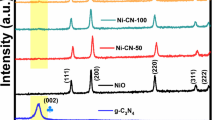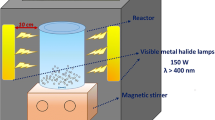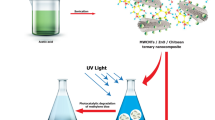Abstract
Appropriate material selection and proper understanding of bandgap modification are key factors for the development of efficient photocatalysts. Herein, we developed an efficient, well-organized visible light oriented photocatalyst based on g-C3N4 in association with polymeric network of chitosan (CTSN) and platinum (Pt) nanoparticles utilizing a straightforward chemical approach. Modern techniques like XRD, XPS, TEM, FESEM, UV–Vis, and FTIR spectroscopy were exploited for characterization of synthesized materials. XRD results confirmed the involvement of α-polymorphic form of CTSN in graphitic carbon nitride. XPS investigation confirmed the establishment of trio photocatalytic structure among Pt, CTSN, and g-C3N4. TEM examination showed that the synthesized g-C3N4 possesses fine fluffy sheets like structure (100 to 500 nm in size) intermingled with a dense layered framework of CTSN with good dispersion of Pt nanoparticles on g-C3N4 and CTSN composite structure. The bandgap energies for g-C3N4, CTSN/g-C3N4, and Pt@ CTSN/g-C3N4 photocatalysts were found to be 2.94, 2.73, and 2.72 eV, respectively. The photodegradation skills of each created structure have been examined on antibiotic gemifloxacin mesylate and methylene blue (MB) dye. The newly developed Pt@CTSN/g-C3N4 ternary photocatalyst was found to be efficacious for the elimination of gemifloxacin mesylate (93.3%) in 25 min and MB (95.2%) just in 18 min under visible light. Designed Pt@CTSN/g-C3N4 ternary photocatalytic framework exhibited ⁓ 2.20 times more effective than bare g-C3N4 for the destruction of antibiotic drug. This study provides a simple route towards the designing of rapid, effective visible light oriented photocatalyts for the existing environmental issues.













Similar content being viewed by others
Data availability
Data and materials generated in this work are included in this article. Correspondence and requests for data and materials should be addressed to Farid A. Harraz.
References
Akhundi A, Habibi-Yangjeh A, Abitorabi M, Pouran SR (2019) Review on photocatalytic conversion of carbon dioxide to value-added compounds and renewable fuels by graphitic carbon nitride-based photocatalysts. Catalysis Reviews 61:595–628. https://doi.org/10.1080/01614940.2019.1654224
Akhundi A, Badiei A, Ziarani GM, Habibi-Yangjeh A, Muñoz-Batista MJ, Luque R (2020) Graphitic carbon nitride-based photocatalysts: toward efficient organic transformation for value-added chemicals production. Mol Catal 488:110902. https://doi.org/10.1016/j.mcat.2020.110902
Anandan S, Vinu A, Venkatachalam N, Arabindoo B, Murugesan V (2006) Photocatalytic activity of ZnO impregnated Hβ and mechanical mix of ZnO /Hβ in the degradation of monocrotophos in aqueous solution. J Mol Catal A Chem 256:312–320. https://doi.org/10.1016/j.molcata.2006.05.012
Atabaev TS, Hossain MA, Lee D, Kim HK, Hwang YH (2016) Pt-coated TiO2 nanorods for photoelectrochemical water splitting applications. Results Phys 6:373–376. https://doi.org/10.1016/j.rinp.2016.07.002
Bahal M, Kaur N, Sharotri N, Sud D (2019) Investigations on amphoteric chitosan/TiO2 bionanocomposites for application in visible light induced photocatalytic degradation. Adv Polym Technol 2345631. https://doi.org/10.1155/2019/2345631
Bakbolat B, Daulbayev C, Sultanov F, Beissenov R, Umirzakov A, Mereke A, Bekbaev A, Chuprakov I (2020) Recent developments of TiO2-based photocatalysis in the hydrogen evolution and photodegradation: a review. Nanomaterials 10:1790. https://doi.org/10.3390/nano10091790
Bouzid H, Faisal M, Harraz FA, Al-Sayari SA, Ismail AA (2015) Synthesis of mesoporous Ag/ZnO nanocrystals with enhanced photocatalytic activity. Catal Today 252:20–26. https://doi.org/10.1016/j.cattod.2014.10.011
Bozorgpour F, Ramandi HF, Jafari P, Samadi S, Yazd SS, Aliabadi M (2016) Removal of nitrate and phosphate using chitosan/Al2O3/Fe3O4 composite nanofibrous adsorbent: comparison with chitosan/Al2O3/Fe3O4 beads. Int J Biol Macromol 93:557–565. https://doi.org/10.1016/j.ijbiomac.2016.09.015
Chen AH, Liu SC, Chen CY (2008) Comparative adsorption of Cu (II), Zn (II) and Pb (II) ions in aqueous solution on the cross linked chitosan with epichlorohydrin. J Hazard Mater 154:184–191. https://doi.org/10.1016/j.jhazmat.2007.10.009
Chen X, Zhang J, Fu X, Antonietti M, Wang X (2009) Fe-g-C3N4-catalyzed oxidation of benzene to phenol using hydrogen peroxide and visible light. J Am Chem Soc 131:11658–11659. https://doi.org/10.1021/ja903923s
Crini G, Lichtfouse E (2019) Advantages and disadvantages of techniques used for wastewater treatment. Environ Chem Lett 17:145–155. https://doi.org/10.1007/s10311-018-0785-9
Daniel MC, Astruc D (2004) Gold nanoparticles: assembly, supramolecular chemistry, quantum-size-related properties, and applications toward biology, catalysis, and nanotechnology. Chem Rev 104:293–346. https://doi.org/10.1021/cr030698+
Ding M, Zhou J, Yang H, Cao R, Zhang S, Shao M, Xu X (2020) Synthesis of Z-scheme g-C3N4 nanosheets/Ag3PO4 photocatalysts with enhanced visible-light photocatalytic performance for the degradation of tetracycline and dye. Chin Chem Lett 31:71. https://doi.org/10.1016/j.cclet.2019.05.029
Dong F, Wu L, Sun Y, Wu FuM, Wu Z, Lee SC (2011) Efficient synthesis of polymeric g- C3N4 layered materials as novel efficient visible light driven photocatalysts. J Mater Chem 21:15171–15174. https://doi.org/10.1039/C1JM12844B
Dong G, Zhang L (2012) Porous structure dependent photoreactivity of graphitic carbon nitride under visible light. J Mater Chem 22:1160–1166. https://doi.org/10.1039/C1JM14312C
Elmalem E, Saunders AE, Costi R, Salant A, Banin U (2008) Growth of photocatalytic CdSe-Pt nanorods and nanonets. Adv Mater 20:4312–4317. https://doi.org/10.1002/adma.200800044
Faisal M, Ismail AA, Harraz FA, Al-Sayari SA, El-Toni AM, Al-Assiri MS (2016) Synthesis of highly dispersed silver doped g-C3N4 nanocomposites with enhanced visiblelight photocatalytic activity. Mater Des 98:223–230. https://doi.org/10.1016/j.matdes.2016.03.019
Faisal M, Harraz FA, Ismail AA, El-Toni AM, Al-Sayari SA, Hajry AA, Al-Assiri MS (2018) Polythiophene/mesoporous SrTiO3 nanocomposites with enhanced photocatalytic activity under visible light. Separ Purif Technol 190:33–44. https://doi.org/10.1016/j.seppur.2017.08.037
Faisal M, Rashed MA, Alhmami MAM, Harraz FA (2021) Clean light oriented ultrafast Pt/Bi2S3 nanoflakes for the photocatalytic destruction of gemifloxacin mesylate drug and methylene blue. J Photoch PhotobioA 414:113288. https://doi.org/10.1016/j.jphotochem.2021.113288
Faisal M, Ahmed J, Rashed MA, Alsareii SA, Harraz FA (2022a) Ag nanoparticles-polypyrrole-carbon black/mesoporous TiO2 novel nanocomposite as ultrafast visible-light-driven photocatalyst. Ceram Int 48:16997–17008. https://doi.org/10.1016/j.ceramint.2022.02.255
Faisal M, Rashed MA, Ahmed J, Alhmami MAM, Asif khan MK, Jalalah M, Alsareii SA, Harraz FA (2022b) Pt nanoparticles decorated chitosan/ZnTiO3: ternary visible-light photocatalyst for ultrafast treatment of insecticide imidacloprid and methylene blue. J Taiwan Inst Chem Eng 133:104266. https://doi.org/10.1016/j.jtice.2022.104266
Fang S, Xia Y, Lv K, Li Q, Sun J, Li M (2016) Effect of carbon-dots modification on the structure and photocatalytic activity of g-C3N4. Appl Catal B Environ 185:225–232. https://doi.org/10.1016/j.apcatb.2015.12.025
Fan X, Zhang L, Cheng R, Wang M, Li M, Zhou Y, Shi J (2015) Construction of graphitic C3N4-based intramolecular donor-acceptor conjugated copolymers for photocatalytic hydrogen evolution. ACS Catal 5:5008–5015. https://doi.org/10.1021/acscatal.5b01155
Farhadian N, Akbarzadeh R, Pirsaheb M, Jen TC, Fakhri Asadi YA (2019) Chitosan modified N, S-doped TiO2 and N, S-doped ZnO for visible light photocatalytic degradation of tetracycline. Int J Biol Macromol 132:360–373. https://doi.org/10.1016/j.ijbiomac.2019.03.217
Ge M, Li Q, Cao C, Huang J, Li S, Zhang S, Chen Z, Zhang K, Al-Deyab SS, Lai Y (2017) One-dimensional TiO2 nanotube photocatalysts for solar water splitting. Adv Sci 4(1):1600152. https://doi.org/10.1002/advs.201600152
Helal A, Harraz FA, Ismail AA, Sami TM, Ibrahim IA (2017) Hydrothermal synthesis of novel heterostructured Fe2O3/Bi2S3 nanorods with enhanced photocatalytic activity under visible light. Appl Catal B 213:18–27. https://doi.org/10.1016/j.apcatb.2017.05.009
Habibi-Yangjeh A, Asadzadeh-Khaneghah S, Feizpoor S, Rouhi A (2020) Review on heterogeneous photocatalytic disinfection of waterborne, airborne, and foodborne viruses: can we win against pathogenic viruses? J Colloid Interface Sci 580:503–514. https://doi.org/10.1016/j.jcis.2020.07.047
Ismail AA, Faisal M, Al-Haddad A (2018) Mesoporous WO3-graphene photocatalyst for photocatalytic degradation of MB dye under visible light illumination. J Environ Sci 66:328–337. https://doi.org/10.1016/j.jes.2017.05.001
Jalalah M, Faisal M, Bouzid H, Park JG, Al-Sayari SA, Ismail AA (2015) Comparative study on photocatalytic performances of crystalline α- and β-Bi2O3 nanoparticles under visible-light. J Ind Eng Chem 30:183–189. https://doi.org/10.1016/j.jiec.2015.05.020
Jiang L, Wang Y, Feng C (2012a) Application of photocatalytic technology in environmental safety. Procedia Eng 45:993–997. https://doi.org/10.1016/j.proeng.2012.08.271
Jiang L, Yuan X, Zeng G, Wu Z, Liang J, Chen X, Leng L, Wang H (2018) Metal-free efficient photocatalyst for stable visible-light photocatalytic degradation of refractory pollutant. Appl Catal B Environ 221:715–725. https://doi.org/10.1016/j.apcatb.2017.09.059
Jiang R, Zhu H, Yao J, Fu Y, Guan Y (2012b) Chitosan hydrogel films as a template for mild biosynthesis of CdS quantum dots with highly efficient photocatalytic activity. Appl Surf Sci 258:3513–3518. https://doi.org/10.1016/j.apsusc.2011.11.105
Kannusamy P, Sivalingam T (2013) Synthesis of porous chitosan–polyaniline/ZnO hybrid composite and application for removal of reactive orange 16 dye. Colloids Surf B Biointerfaces 108:229. https://doi.org/10.1016/j.colsurfb.2013.03.015
Karthikeyan KT, Nithya A, Jothivenkatachalam K (2017) Photocatalytic and antimicrobial activities of chitosan-TiO2 nanocomposite. Int J Biol Macromol 104:1762–1773. https://doi.org/10.1016/j.ijbiomac.2017.03.121
Khaneghah SA, Yangjeh AH (2020) g-C3N4/carbon dot-based nanocomposites serve as efficaciousphotocatalysts for environmental purification and energy generation: a review. J Clean Prod 276:124319. https://doi.org/10.1016/j.jclepro.2020.124319
Kumaravel V, Mathew S, Bartlett J, Pillai SC (2019) Photocatalytic hydrogen production using metal doped TiO2: a review of recent advances. Appl Catal B Environ 244:1021–1064. https://doi.org/10.1016/j.apcatb.2018.11.080
Langhammer C, Yuan Z, Zoric I, Kasemo B (2006) Plasmonic properties of supported Pt and Pd nanostructures. Nano Lett 6:833–838. https://doi.org/10.1021/nl060219x
Li Y, Zhao Y, Fan L, Jin R, Yang Y, Xing Y (2014) Highly efficient composite visible light-driven Ag–AgBr/g-C3N4 plasmonic photocatalyst for degrading organic pollutants. Mater Lett 126:5–8. https://doi.org/10.1016/j.matlet.2014.04.010
Liu J, Yang Y, Liu NY, Han YZ, Zhang X, Huang H, Lifshitz Y, Lee ST, Zhong J, Kang ZH (2015) Water splitting. Metal-free efficient photocatalyst for stable visible water splitting via a two-electron pathway. Science 347(2015):970–974. https://doi.org/10.1126/science.aaa3145
Liu QY, Qi YL, Zheng YF, Song XC (2017) Synthesis and enhanced photocatalytic activity of g-C3N4 hybridized CdS nanoparticles. Bull Mater Sci 40:1329–1333. https://doi.org/10.1007/s12034-017-1513-y
Martha S, Nashim A, Parida KM (2013) Facile synthesis of highly active g-C3N4 for efficient hydrogen production under visible light. J Mater Chem 1:7816–7824. https://doi.org/10.1039/C3TA10851A
Miao X, Yue Y, Ji Z, Shen X, Zhou H, Liu M, Xu K, Zhu J, Zhu G, Kong L, Shah SA (2018) Nitrogen-doped carbon dots decorated on g-C3N4/Ag3PO4 photocatalyst with improved visible light photocatalytic activity and mechanism insight. Appl Catal B Environ 227:459–469. https://doi.org/10.1016/j.apcatb.2018.01.057
Min Z, Wang X, Li Y, Jiang J, Li J, Qian D, Li J (2017) A highly efficient visible-light responding Cu2O-TiO2/g-C3N4 photocatalyst for instantaneous discolorations of organic dyes. Mater Lett 193:18–21. https://doi.org/10.1016/j.matlet.2017.01.083
Mitsuyama T, Katsumata H, Suzuki T, Kaneco S (2017) Enhanced photocatalytic activity of phosphorus-doped graphitic carbon nitride under visible light irradiation. ECS Trans 75:47–56. https://doi.org/10.1149/07550.0047ecst
Mo Z, Xu H, Chen Z, She X, Song Y, Wu J, Yan P, Xu L, Lei Y, Yuan S, Li H (2018) Self-assembled synthesis of defect-engineered graphitic carbon nitride nanotubes for efficient conversion of solar energy. Appl Catal B 225:154–161. https://doi.org/10.1016/j.apcatb.2017.11.041
Mousavi M, Yangjeh AH (2016) Magnetically separable ternary g-C3N4/Fe3O4/BiOI nanocomposites: novel visible-light-driven photocatalysts based on graphitic carbon nitride. J Colloid Interface Sci 465:83–92. https://doi.org/10.1016/j.jcis.2015.11.057
Nakai Y, Katsumata H, Suzuki T, Kaneco S (2017) Highly efficient visible-light-driven photocatalytic H2 production using carbon particle/g-C3N4 photocatalysts with an electron donor. ECS Trans 75:75. https://doi.org/10.1149/07550.0075ecst
Nawi NA, Jawad AH, Sabar S, Ngah WSW (2011) Immobilized bilayer TiO2/chitosan system for the removal of phenol under irradiation by a 45 watt compact fluorescent lamp. Desalination 280(1):288–296. https://doi.org/10.1016/j.desal.2011.07.013
Niu P, Zhang L, Liu G, Cheng HM (2012) Graphene-like carbon nitride nanosheets for improved photocatalytic activities. Adv Funct Mater 22:4763–4770. https://doi.org/10.1002/adfm.201200922
Ong WJ, Tan LL, Ng YH, Yong ST, Chai SP (2016) Graphitic carbon nitride (g-C3N4)-based photocatalysts for artificial photosynthesis and environmental remediation: are we a step closer to achieving sustainability? Chem Rev 116:7159–7329. https://doi.org/10.1021/acs.chemrev.6b00075
Park H, Choi W (2005) Photocatalytic reactivities of nafion-coated TiO2 for the degradation of charged organic compounds under UV or visible –light. J Phys Chem B 109:11667–11674. https://doi.org/10.1021/jp051222s
Poulopoulos SG, Yerkinova A, Ulykbanova G, Inglezakis VJ (2019) Photocatalytic treatment of organic pollutants in a synthetic wastewater using UV light and combinations of TiO2, H2O2 and Fe(III). PLoS ONE 14:e0216745. https://doi.org/10.1371/journal.pone.0216745
Rajasulochana P, Preethy V (2016) Comparison on efficiency of various techniques in treatment of waste and sewage water – a comprehensive review. Resour-Effic Technol 2:175–184. https://doi.org/10.1016/j.reffit.2016.09.004
Rajender G, Kumar J, Gir PK (2018) Interfacial charge transfer in oxygen deficient TiO2-graphene quantum dot hybrid and its influence on the enhanced visible light photocatalysis. Appl Catal B Environ 224:960–972. https://doi.org/10.1016/j.apcatb.2017.11.042
Ran RJ, Ma TY, Gao G, Du XW, Qiao SZ (2015) Porous P-doped graphitic carbon nitride nanosheets for synergistically enhanced visible-light photocatalytic H2 production. Energy Environ Sci 8:3708–3717. https://doi.org/10.1039/C5EE02650D
Raut AV, Yadav HM, Gnanamani A, Pushpavanam S, Pawar SH (2016) Synthesis and characterization of chitosan-TiO2: Cu nanocomposite and their enhanced antimicrobial activity with visible light. Colloids Surf B Biointerfaces 148:566–575. https://doi.org/10.1016/j.colsurfb.2016.09.028
Samanta S, Martha S, Parida K (2014) Facile synthesis of Au/g-C3N4 nanocomposites: an inorganic/organic hybrid plasmonic photocatalyst with enhanced hydrogen gas evolution under visible-light irradiation. Chem Cat Chem 6:1453–1462. https://doi.org/10.1002/cctc.201300949
Sivaranjini B, Mangaiyarkarasi R, Ganesh V, Umadevi S (2018) Vertical alignment of liquid crystals over a functionalized flexible substrate. Sci Rep 8:8891. https://doi.org/10.1038/s41598-018-27039-3
Speltini A, Pisanu A, Profumo A, Milanese C, Sangaletti L, Drera G, Patrini M, Pentimalli M, Malavasi L (2018) Rationalization of hydrogen production by bulk g-C3N4: an in-depth correlation between physico-chemical parameters and solar light photocatalysis. RSC Adv 8:39421–39431. https://doi.org/10.1039/C8RA08880B
Tang H, Wang R, Zhao C, Chen Z, Yang X, Boukhvalov DW, Lin Z, Liu Q (2019) Oxamide-modified g-C3N4 nanostructures: tailoring surface topography for high-performance visible light photocatalysis. Chem Eng J 374:1064–1075. https://doi.org/10.1016/j.cej.2019.06.029
Tasbihia M, Schwarzea M, Edelmannováb M, Spöric C, Strasserc P, Schomäcker R (2019) Photocatalytic reduction of CO2 to hydrocarbons by using photodeposited Pt nanoparticles on carbon-doped titania. Catal Today 328:8–14. https://doi.org/10.1016/j.cattod.2018.10.011
Tonda S, Kumar S, Shanker V (2016) Surface plasmon resonance-induced photocatalysis by Au nanoparticles decorated mesoporous g-C3N4 nanosheets under direct sunlight irradiation. Mater Res Bull 75:51–58. https://doi.org/10.1016/j.materresbull.2015.11.011
Tong H, Ouyang SH, Bi YP, Umezawa N, Oshikiri M, Ye JH (2012) Nano-photocatalytic materials: possibilities and challenges. Adv Mater 24:229–251. https://doi.org/10.1002/adma.201102752
Wang H, Wang B, Bian Y, Dai L (2017) Enhancing photocatalytic activity of graphitic carbon nitride by codoping with P and C for efficient hydrogen generation. ACS Appl Mater Interfaces 9:21730–21737. https://doi.org/10.1021/acsami.7b02445
Wang K, Wang H, Pasupathi S, Linkov V, Ji S, Wang R (2012a) Palygorskite promoted PtSn/carbon catalysts and their intrinsic catalytic activity for ethanol oxidation. Electrochim Acta 70:394–401. https://doi.org/10.1016/j.electacta.2012.03.111
Wang X, Maeda K, Thomas A, Takanabe K, Xin G, Carlsson JM, Domen K, Antonietti M (2009) A metal-free polymeric photocatalyst for hydrogen production from water under visible light. Nat Mater 8:76–80. https://doi.org/10.1038/nmat2317
Wang X, Zhang W, Gong X, Hu X, Yao X (2019) In situ decomposition-thermal polymerization method for the synthesis of Au nanoparticle decorated g-C3N4 nanosheets with enhanced sunlight-driven photocatalytic activity. J Nanopart Res 21:192. https://doi.org/10.1007/s11051-019-4613-3
Wang Y, Zhang J, Wang X, Antonietti M, Li H (2010) Boron- and fuorine-containing mesoporous carbon nitride polymers: metal-free catalysts for cyclohexane oxidation. Angew Chem Int Ed 49:3356–3359. https://doi.org/10.1002/anie.201000120
Wang Y, Wang X, Antonietti M (2012b) Polymeric graphitic carbon nitride as a heterogeneous organocatalyst: from photochemistry to multipurpose catalysis to sustainable chemistry. Angew Chem Int Ed 51:68–89. https://doi.org/10.1002/anie.201101182
Wu X, Gao D, Yu H, Yu J (2019) High-yield lactic acid-mediated route for a g-C3N4 nanosheet photocatalyst with enhanced H2- evolution performance. Nanoscale 11:9608–9616. https://doi.org/10.1039/C9NR00887J
Xiong ZG, Zhao XS (2012) Nitrogen-doped titanate-anatase core–shell nanobelts with exposed 101 anatase facets and enhanced visible light photocatalytic activity. J Am Chem Soc 134:5754–5757. https://doi.org/10.1021/ja300730c
Xu B, Ahmed MB, Zhou JL, Altaee A, Xu G, Wu M (2018) Graphitic carbon nitride based nanocomposites for the photocatalysis of organic contaminants under visible irradiation: progress, limitations and future directions. Sci Total Environ 633:546–559. https://doi.org/10.1016/j.scitotenv.2018.03.206
Yang Y, Yang XA, Leng D, Wang SB, Zhang WB (2018) Fabrication of g-C3N4/SnS2/ SnO2 nanocomposites for promoting photocatalytic reduction of aqueous Cr(VI) under visible light. Chem Eng J 335:491–500. https://doi.org/10.1016/j.cej.2017.10.173
Zainal Z, Hui LK, Hussein MZ, Abdullah AH (2009) Characterization of TiO2–chitosan/ glass photocatalyst for the removal of a monoazo dye via photodegradation– adsorption process. J Hazard Mater 164(1):138–145. https://doi.org/10.1016/j.jhazmat.2008.07.154
Zhang X, Xie X, Wang H, Zhang J, Pan B, Xie Y (2013) Enhanced photoresponsive ultrathin graphitic-phase C3N4 nanosheets for bioimaging. J Am Chem Soc 135:18–21. https://doi.org/10.1021/ja308249k
Zhang Z, Huang J, Zhang M, Yuan Q, Dong B (2015) Ultrathin hexagonal SnS2 nanosheets coupled with g-C3N4 nanosheets as 2D/2D heterojunction photocatalysts toward high photocatalytic activity. Appl Catal B 163:298–305. https://doi.org/10.1016/j.apcatb.2014.08.013
Zhao C, Yan Q, Wang S, Dong P, Zhang L (2018) Regenerable g-C3N4–chitosan beads with enhanced photocatalytic activity and stability. RSC Adv 8:27516–27524. https://doi.org/10.1039/C8RA04293D
Zhao Z, Sun Y, Dong F (2015) Graphitic carbon nitride based nanocomposites: a review. Nanoscale 7:15. https://doi.org/10.1039/c4nr03008g
Zhou S, Liu Y, Li JM, Wang YJ, Jiang GY, Zhao Z, Wang DX, Duan AJ, Liu J, Wei YC (2014) Facile in situ synthesis of graphitic carbon nitride (g-C3N4)-N-TiO2 heterojunction as an efficient photocatalyst for the selective photoreduction of CO2 to CO. Appl Catal B 158:20–29. https://doi.org/10.1016/j.apcatb.2014.03.037
Zhou X, Jin B, Li L, Peng F, Wang H, Yu H, Fang Y (2012) A carbon nitride/TiO2 nanotube array heterojunction visible-light photocatalyst: synthesis, characterization, and photoelectrochemical properties. J Mater Chem 22:17900–17905. https://doi.org/10.1039/C2JM32686H
Zhu H, Jiang R, Fu Y, Guan Y, Yao J, Xiao L, Zeng G (2012) Effective photocatalytic decolorization of methyl orange utilizing TiO2/ZnO/chitosan nanocomposite films under simulated solar irradiation. Desalination 286:41–48. https://doi.org/10.1016/j.desal.2011.10.036
Zhu JJ, Xiao P, Li HL, Carabineiro SA (2014) Graphitic carbon nitride: synthesis, properties, and applications in catalysis. ACS Appl Mater Interfaces 6:16449–16465. https://doi.org/10.1021/am502925j
Funding
This research was supported by the Deanship of Scientific Research at Najran University, Kingdom of Saudi Arabia under the National Research Priorities Funding Program: grant code (NU/NRP/SERC/11/2).
Author information
Authors and Affiliations
Contributions
Mohd Faisal: methodology, investigation, materials analysis, and writing—original draft; Jahir Ahmed: electrochemical investigation and reviewing and editing; Mohammed Jalalah: reviewing and editing; Saeed Alsareii: reviewing and editing; Mabkhoot Alsaiari: reviewing and editing; Farid Harraz: writing—review and editing—and work supervision.
Corresponding author
Ethics declarations
Ethics approval
Not applicable.
Consent to participate
Not applicable.
Consent for publication
All the authors revised and approved the manuscript.
Competing interests
The authors declare no competing interests.
Additional information
Responsible Editor: Sami Rtimi
Publisher's note
Springer Nature remains neutral with regard to jurisdictional claims in published maps and institutional affiliations.
Rights and permissions
Springer Nature or its licensor (e.g. a society or other partner) holds exclusive rights to this article under a publishing agreement with the author(s) or other rightsholder(s); author self-archiving of the accepted manuscript version of this article is solely governed by the terms of such publishing agreement and applicable law.
About this article
Cite this article
Faisal, M., Ahmed, J., Jalalah, M. et al. Rapid elimination of antibiotic gemifloxacin mesylate and methylene blue over Pt nanoparticles dispersed chitosan/g-C3N4 ternary visible light photocatalyst. Environ Sci Pollut Res 30, 61710–61725 (2023). https://doi.org/10.1007/s11356-023-26456-w
Received:
Accepted:
Published:
Issue Date:
DOI: https://doi.org/10.1007/s11356-023-26456-w




